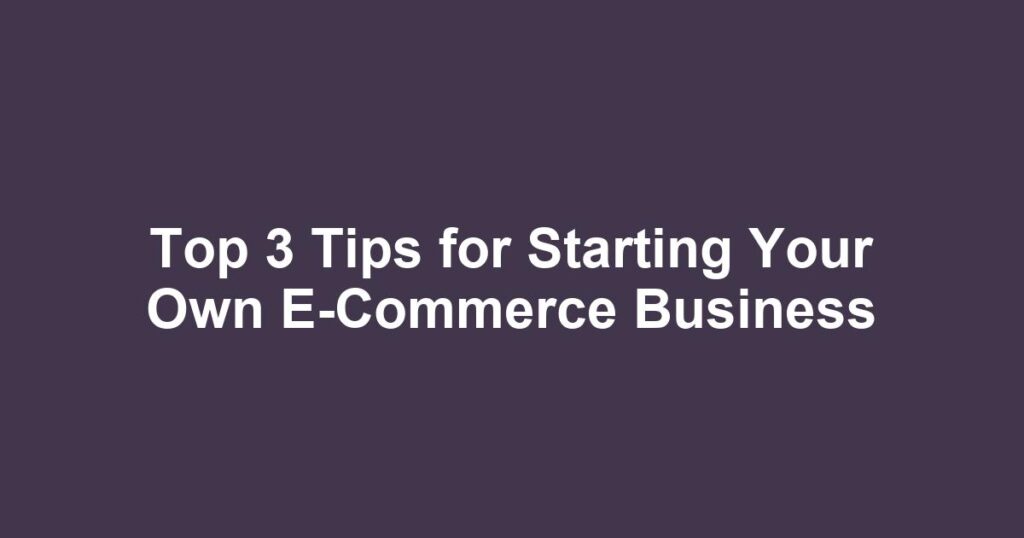Top 3 Tips for Starting Your Own E-Commerce Business
In today’s digital age, starting your own e-commerce business is not just a trend; it’s a necessity for aspiring entrepreneurs. With more consumers turning to online shopping, there has never been a better time to jump into the e-commerce world. However, the vast landscape of online business can be daunting. How do you ensure your e-commerce venture stands out? In this article, we’ll share the top three tips to kickstart your e-commerce business effectively.
Understanding the E-Commerce Landscape
Before diving into the tips, it’s essential to grasp the e-commerce landscape. E-commerce involves selling goods or services online and encompasses various business models, including B2C (business-to-consumer), B2B (business-to-business), and even C2C (consumer-to-consumer) platforms. This broad range means there’s plenty of room to carve out your niche. So, what should you focus on? Let’s explore!
Tip 1: Choose Your Niche Wisely
Importance of a Niche
Choosing the right niche is critical to your e-commerce business’s success. Having a specific focus allows you to target your marketing efforts effectively and build a loyal customer base. Here are some steps to identify your niche:
- Market Research: Analyze current market trends and consumer behaviors. What products are in demand? What gaps exist that you could fill?
- Passion and Expertise: Consider your interests and expertise. Combining passion with market needs often leads to successful entrepreneurship.
- Competitive Analysis: Study your competitors. What are they offering? How can you differentiate your e-commerce business?
Examples of Successful Niches
Here are some niches that have proven to be successful in the e-commerce industry:
- Sustainable products
- Health and wellness items
- Customized goods
- Subscription boxes
By selecting a niche that resonates with you and potential customers, you set the foundation for a thriving e-commerce business.
Tip 2: Build a User-Friendly Website
The Role of Your Website
Your e-commerce website acts as your storefront in the digital world. It’s not only where sales happen; it’s also where customer interactions begin. To avoid losing customers due to a subpar website experience, focus on the following:
- Responsive Design: Ensure your site is mobile-friendly. A significant portion of online shopping is done via smartphones.
- Easy Navigation: Organize your products logically and make it easy for customers to find what they are looking for.
- Fast Loading Times: Optimize images and minimize scripts to ensure your website loads quickly. Slow websites can drive potential customers away.
Essential Features for Success
Integrating specific features can elevate your e-commerce site:
- Secure Payment Options: Offer multiple payment methods (credit cards, PayPal, etc.) to cater to various preferences.
- High-Quality Images and Descriptions: Use professional images and detailed, engaging product descriptions to attract potential buyers.
- Customer Reviews: Allow customers to leave reviews. Positive testimonials can significantly influence purchasing decisions.
Tip 3: Develop a Marketing Strategy
Why Marketing Matters
Even the best e-commerce website won’t succeed without a solid marketing strategy. Since you’re just starting out, utilizing cost-effective marketing tactics is vital for growth:
- Social Media Marketing: Leverage platforms such as Instagram, Facebook, and Pinterest to reach your target audience. Showcasing your products visually can drive traffic to your site.
- Email Marketing: Build an email list and communicate with your audience. Offer newsletters, discounts, and personalized product recommendations.
- Content Marketing: Create valuable content related to your niche. Blog posts, videos, and infographics can draw organic traffic and establish your authority in the field.
Effective Advertising Options
Consider experimenting with different advertising channels:
- Pay-Per-Click (PPC) Advertising: Use Google Ads or Facebook Ads to reach a broader audience.
- SEO: Optimize your website for search engines. Use relevant keywords in your product descriptions and blog content to enhance your visibility online.
- Influencer Partnerships: Collaborate with influencers who can promote your brand to their audience.
Frequently Asked Questions
How to Choose the Right E-Commerce Platform?
Consider factors like ease of use, payment integration, scalability, and cost when selecting an e-commerce platform. Popular options include Shopify, WooCommerce, and BigCommerce.
What Is the Importance of Customer Support in E-Commerce?
Providing excellent customer support can enhance customer loyalty and retention. Consider offering multiple channels for support, such as live chat, email, and phone support.
Conclusion
Starting your e-commerce business can be an overwhelming yet rewarding journey. By choosing the right niche, building a user-friendly website, and developing a solid marketing strategy, you can position your online store for success. Remember, entrepreneurship requires patience and adaptability. So take these tips to heart, and get ready to embark on your exciting new venture!
If you’re ready to dive into the world of online shopping, don’t wait! Start implementing these business tips today and watch your e-commerce business flourish!
Call to Action
Ready to take the leap into e-commerce? Begin your journey now by researching your niche, creating your website, and strategizing your marketing efforts. The sooner you start, the sooner you can achieve your entrepreneurial dreams!

